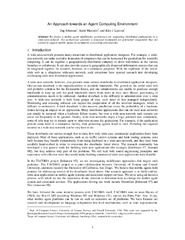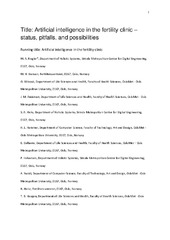Blar i tittel Artikler, rapporter og annet (informatikk)
Viser treff 13-32 av 389
-
An approach towards an agent computing environment
(Research report; Forskningsrapport, 1998)We devise a mobile agent middleware architecture for supporting distributed applications in a wide-area network. The architecture provides a structural framework for functional components that are needed to support mobile agents in asymmetric networking environments. -
Approximate Bayesian Inference Based on Expected Evaluations
(Journal article; Tidsskriftartikkel; Peer reviewed, 2023-02-01)Approximate Bayesian computing (ABC) and Bayesian Synthetic likelihood (BSL) are two popular families of methods to evaluate the posterior distribution when the likelihood function is not available or tractable. For existing variants of ABC and BSL, the focus is usually first put on the simulation algorithm, and after that the form of the resulting approximate posterior distribution comes as a ... -
Arctic beans containers composition of non-functional services using composition filters
(Research report; Forskningsrapport, 2005)It is becoming clear that modern middleware platforms must provide both deploy-time configuration and run-time reconfiguration to accommodate rapid changing requirements and also to be able to operate in dynamic environments. J2EE is a key example of a middleware architecture that supports enterprise applications via its Enterprise JavaBeans (EJB) component model. EJB provides limited configurability ... -
Are health videos from hospitals, health organizations, and active users available to health consumers? An analysis of diabetes health video ranking in YouTube
(Journal article; Tidsskriftartikkel; Peer reviewed, 2017-01-24)Health consumers are increasingly using the Internet to search for health information. The existence of overloaded, inaccurate, obsolete, or simply incorrect health information available on the Internet is a serious obstacle for finding relevant and good-quality data that actually helps patients. Search engines of multimedia Internet platforms are thought to help users to find relevant information ... -
Are object detection assessment criteria ready for maritime computer vision?
(Journal article; Tidsskriftartikkel; Peer reviewed, 2019-11-25)Maritime vessels equipped with visible and infrared cameras can complement other conventional sensors for object detection. However, application of computer vision techniques in maritime domain received attention only recently. The maritime environment offers its own unique requirements and challenges. Assessment of the quality of detections is a fundamental need in computer vision. However, the ... -
Artificial intelligence in dry eye disease
(Journal article; Tidsskriftartikkel, 2021-11-27)Dry eye disease (DED) has a prevalence of between 5 and 50%, depending on the diagnostic criteria used and population under study. However, it remains one of the most underdiagnosed and undertreated conditions in ophthalmology. Many tests used in the diagnosis of DED rely on an experienced observer for image interpretation, which may be considered subjective and result in variation in diagnosis. ... -
Artificial intelligence in the fertility clinic: status, pitfalls and possibilities
(Journal article; Tidsskriftartikkel; Peer reviewed, 2021-07-29)In recent years, the amount of data produced in the field of ART has increased exponentially. The diversity of data is large, ranging from videos to tabular data. At the same time, artificial intelligence (AI) is progressively used in medical practice and may become a promising tool to improve success rates with ART. AI models may compensate for the lack of objectivity in several critical procedures ... -
Augmented Reality enhanced device usage training tool for in-home health-self-monitoring by pregnant women
(Journal article; Tidsskriftartikkel, 2023-09)Virtual care comprising virtual visits and monitoring via audio or video has the potential to reduce access barriers to care and has been successfully implemented in prenatal care. It reduces the frequency of in-person visits and increases self-care skills. However, the knowledge and competence in handling monitoring equipment at home directly influences satisfaction and engagement with the ... -
Augmenting SQLite for Local-First Software
(Journal article; Tidsskriftartikkel; Peer reviewed, 2021-07-17)Local-first software aims at both the ability to work offline on local data and the ability to collaborate across multiple devices. CRDTs (conflict-free replicated data types) are abstractions for offline and collaborative work that guarantees strong eventual consistency. RDB (relational database) is a mature and successful computer industry for management of data, and SQLite is an ideal RDB candidate ... -
Authorization and access control in a distributed file repository
(Research report; Forskningsrapport, 1999-01-18)A distributed file repository is described. It supports interaction between different machines used by a single user, as well as between users that share data. Files can be replicated and consistency will be maintained, or files can be shipped (copied) to a remote site. As with more traditional systems, the servers are trusted not to leak information. However, the rôle servers play is not as much ... -
Automatic algorithm for determining bone and soft-tissue factors in dual-energy subtraction chest radiography
(Journal article; Tidsskriftartikkel; Peer reviewed, 2022-11-11)Lung cancer is currently the first leading cause of worldwide cancer deaths since the early stage of lung cancer detection is still a challenge. In lung diagnosis, nodules sometimes overlap with ribs and tissues on lung chest radiographic images, which are complex for doctors and radiologists. Dual-energy subtraction (DES) is a suitable solution to solve those issues. This article will develop an ... -
Automatic thumbnail selection for soccer videos using machine learning
(Chapter; Bokkapittel, 2022-08-05)Thumbnail selection is a very important aspect of online sport video presentation, as thumbnails capture the essence of important events, engage viewers, and make video clips attractive to watch. Traditional solutions in the soccer domain for presenting highlight clips of important events such as goals, substitutions, and cards rely on the manual or static selection of thumbnails. However, such ... -
Automatic Unsupervised Clustering of Videos of the Intracytoplasmic Sperm Injection (ICSI) Procedure
(Chapter; Bokkapittel, 2023-02-02)The in vitro fertilization procedure called intracytoplasmic sperm injection can be used to help fertilize an egg by injecting a single sperm cell directly into the cytoplasm of the egg. In order to evaluate, refine and improve the method in the fertility clinic, the procedure is usually observed at the clinic. Alternatively, a video of the procedure can be examined and labeled in a time-consuming ... -
Autostrata: Improved Automatic Stratification for Coarsened Exact Matching
(Chapter; Bokkapittel, 2022-08-22)We commonly adjust for confounding factors in analytical observational epidemiologyto reduce biases that distort the results. Stratification and matching are standard methods for reducing confounder bias. Coarsened exact matching (CEM) is a recent method using stratification to coarsen variables into categorical variables to enable exact matching of exposed and nonexposed ... -
Aux-Drop: Handling Haphazard Inputs in Online Learning Using Auxiliary Dropouts
(Journal article; Tidsskriftartikkel; Peer reviewed, 2023)Many real-world applications based on online learning produce streaming data that is haphazard in nature, i.e., contains missing features, features becoming obsolete in time, the appearance of new features at later points in time and a lack of clarity on the total number of input features. These challenges make it hard to build a learnable system for such applications, and almost no work exists in ... -
Auxiliary Network: Scalable and agile online learning for dynamic system with inconsistently available inputs
(Journal article; Tidsskriftartikkel, 2022-04-13)Streaming classification methods assume the number of input features is fixed and always received. But in many real-world scenarios, some features are reliable while others are unreliable or inconsistent. We propose a novel online deep learning-based model called Auxiliary Network (Aux-Net), which is scalable and agile and can handle any number of inputs at each time instance. The Aux-Net model is ... -
Áika: A Distributed Edge System for AI Inference
(Journal article; Tidsskriftartikkel; Peer reviewed, 2022-06-17)Video monitoring and surveillance of commercial fisheries in world oceans has been proposed by the governing bodies of several nations as a response to crimes such as overfishing. Traditional video monitoring systems may not be suitable due to limitations in the offshore fishing environment, including low bandwidth, unstable satellite network connections and issues of preserving the privacy of crew ... -
The Beauty of Complex Designs
(Chapter; Bokkapittel, 2020-12-08)The increasing use of omics data in epidemiology enables many novel study designs, but also introduces challenges for data analysis. We describe the possibilities for systems epidemiological designs in the Norwegian Women and Cancer (NOWAC) study and show how the complexity of NOWAC enables many beautiful new study designs. We discuss the challenges of implementing designs and analyzing data. Finally, ... -
Behavioural change in green transportation: Micro-economics perspectives and optimization strategies
(Journal article; Tidsskriftartikkel; Peer reviewed, 2021-06-22)The increasing demand for Electric Vehicle (EV) charging is putting pressure on the power grids and capacities of charging stations. This work focuses on how to use indirect control through price signals to level out the load curve in order to avoid the power consumption from exceeding these capacities. We propose mathematical programming models for the indirect control of EV charging that aim at ... -
Building agent applications using wrappers
(Research report; Forskningsrapport, 2001-01-11)For the past seven years, the TACOMA project has investigated software support for mobile agents. Several prototypes have been developed, with experiences in distributed applications directing the effort. This paper presents a new mechanism that supports implementing agent applications by creating troops of agents using wrappers. This solution requires little extra support from the agent system, and ...


 English
English norsk
norsk


















